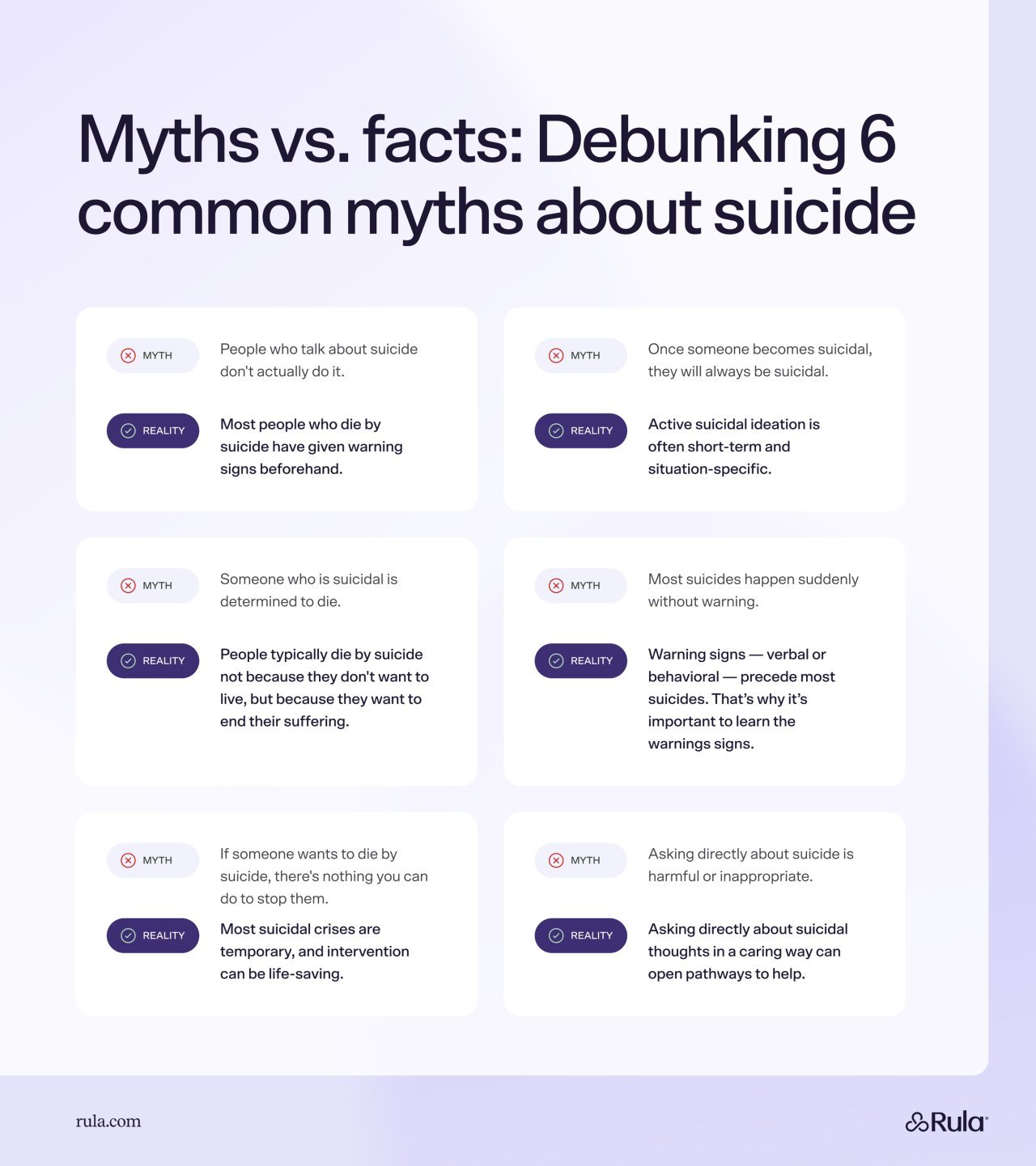While social stigma about suicide means that open conversations about the topic are rare, the reality is that suicide is a leading cause of death in the United States. In 2023, more than 49,000 people died by suicide. That amounts to about one death every 11 minutes.
Despite its prevalence, suicide can still be difficult to talk about. So, in honor of National Suicide Prevention Month, Rula is debunking some common myths related to suicide. Learning the facts about suicide can help you spot the warning signs, challenge stigmas, and potentially save a life.
Key takeaways:
*The 988 Suicide and Crisis Lifeline provides 24/7, confidential support with trained crisis counselors. If you or a loved one is in emotional distress or a suicidal crisis, please call or text 988. If you’re experiencing a life-threatening emergency or you need immediate help, please call 911.

Fact: Most people who die by suicide show warning signs or talk about their suicidal thoughts beforehand. In many cases, this can be a cry for help. If you hear someone make a comment about suicide, always take it seriously. It’s better to be overly cautious than stay silent when someone could be struggling.
Fact: Mental health conditions can increase a person’s risk for suicide, especially if they aren’t getting support. But suicide doesn’t only affect people with a diagnosis. In fact, studies show that about half of the people who die by suicide don’t have a diagnosed mental health condition.
Suicidal thoughts can happen when someone is going through a really hard time — like a big loss, serious stress, or a major life change. These thoughts are often short-term and linked to what’s going on in someone’s life. For people who do have mental health conditions, treatment can help reduce the risk by helping them manage symptoms and find support.
Fact: Typically, people don’t die by suicide because they don’t want to live. Rather, people die by suicide because they want to end their suffering. If you don’t have firsthand experience with this type of pain, it might be tough to imagine being in a position where suicide feels like the only choice. But suicidal thoughts are often about seeking relief — not about giving up on life. With the right support, many people who have felt this way go on to heal and find hope again.
Fact: There are usually verbal or behavioral indicators that someone is at risk for suicide. That’s why it’s so important to learn and understand the warning signs.
Don’t hesitate to reach out to support someone who starts:
Fact: Most suicidal crises are temporary. With the right support, people can get through a crisis. This is because, even in a person’s darkest moments, they may still have mixed feelings. In other words, there might be part of them that wants to live, despite the difficulties they’re facing. Staying with that person, contacting crisis care, and encouraging them to seek ongoing support can help keep them safe.
Fact: Many people worry that bringing up the subject of suicide might “put ideas in someone’s head” or increase the person’s risk. But this isn’t the case. Asking directly about suicidal thoughts in a caring way can provide relief and open pathways to help.
Here are some examples of things you can say:
If the person says “yes,” try to remain calm, validate their feelings, and ask if it’s OK to connect them with resources like the ones listed below. If they’re not ready to talk, try to keep the door open for another conversation. Ask them if it’s OK if you check in later, and be sure to follow up.
Suicide is a common occurrence in the United States. However, it’s still widely misunderstood. For example, some people mistakenly believe that asking someone about suicide will increase their risk. But the truth is, talking about suicide and raising awareness can save a life. Knowing the facts about suicide can help you spot the signs, empower you to intervene, and allow you to connect someone with resources to keep them safe.
This story was produced by Rula and reviewed and distributed by Stacker.
Reader Comments(0)